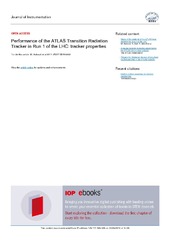Performance of the ATLAS Transition Radiation Tracker in Run 1 of the LHC: Tracker properties
Aaboud, Morad; Aad, Georges; Abbott, Brad; Abdallah, Jalal; Abdinov, Ovsat Bahram oglu; Abeloos, Baptiste; Abidi, Syed Haider; AbouZeid, Hass; Abraham, Nadine L.; Abramowicz, Halina; Buanes, Trygve; Dale, Ørjan; Eigen, Gerald; Liebig, Wolfgang; Lipniacka, Anna; Martin dit Latour, Bertrand; Mæland, Steffen; Smestad, Lillian; Stugu, Bjarne; Yang, Zongchang; Zalieckas, Justas; Cameron, David Gordon; Catmore, James Richard; Feigl, Simon; Franconi, Laura; Garonne, Vincent; Gjelsten, Børge Kile; Gramstad, Eirik; Morisbak, Vanja; Nilsen, Jon Kerr; Ould-Saada, Farid; Raddum, Silje Hattrem; Read, Alexander Lincoln; Røhne, Ole Myren; Sandaker, Heidi; Serfon, Cédric; Stapnes, Steinar; Strandlie, Are; Bugge, Magnar Kopangen; Abreu, Henso; Abreu, Rômulo F.; Abulaiti, Yiming; Acharya, Bobby S.; Adachi, Shunsuke; Adamczyk, Leszek; Adams, David; Adelman, Jareed; Adersberger, Michael; Adye, Tim; Affolder, Anthony Allen; ATLAS, Collaboration
Peer reviewed, Journal article
Published version

Åpne
Permanent lenke
https://hdl.handle.net/1956/18356Utgivelsesdato
2017Metadata
Vis full innførselSamlinger
Originalversjon
https://doi.org/10.1088/1748-0221/12/05/p05002Sammendrag
The tracking performance parameters of the ATLAS Transition Radiation Tracker (TRT) as part of the ATLAS inner detector are described in this paper for different data-taking conditions in proton-proton, proton-lead and lead-lead collisions at the Large Hadron Collider (LHC). The performance is studied using data collected during the first period of LHC operation (Run 1) and is compared with Monte Carlo simulations. The performance of the TRT, operating with two different gas mixtures (xenon-based and argon-based) and its dependence on the TRT occupancy is presented. These studies show that the tracking performance of the TRT is similar for the two gas mixtures and that a significant contribution to the particle momentum resolution is made by the TRT up to high particle densities.
